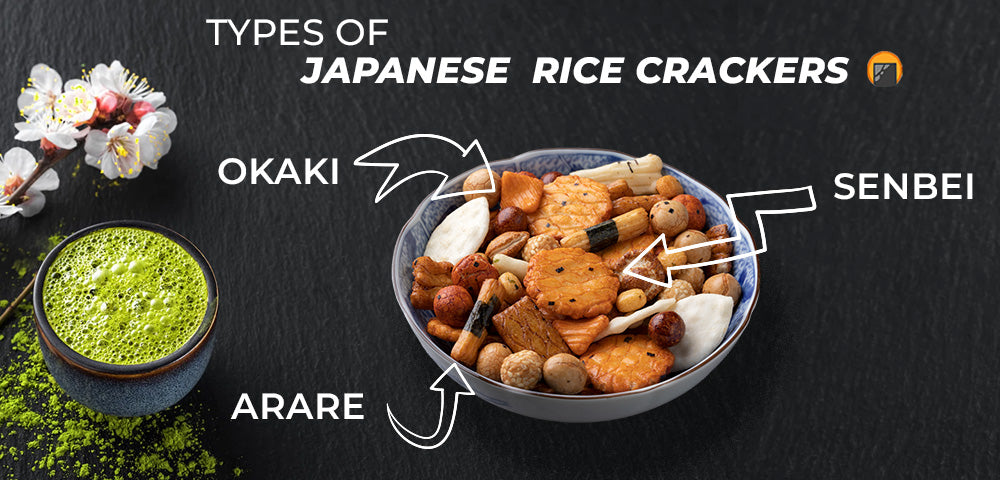Types of Japanese Rice Crackers – Arare, Okaki, and Senbei

Japanese Rice Crackers – Arare, Okaki, and Senbei
Arare, okaki, and senbei are types of Japanese rice crackers. They're usually made with a sweetened rice flour dough that's baked into thin, flat sheets and then cut into shapes. They are popular snacks in Japan, especially during the New Year holiday when they are traditionally eaten with sake or tea.
The main differences between arare, okaki, and senbei are their size and how they're made:
- Arare (small)
- Okaki (medium)
- Senbei (large)
Arare is pressed into thin rounds while okaki are triangular shapes and senbei are rectangular pieces of rice cracker.

History
Senbei were first made in Osaka around 1700 CE as a way to use leftover rice flour from making porridge (mochi).
Okaki were first invented by the people of the Nara region in Japan around 800 years ago. They were originally made to celebrate the harvest season in autumn, but they quickly became popular throughout Japan.
Arare were created later on by pressing okaki into round shapes.
What is arare and what does it look like?
Arare (あられ) is a round bite-sized crunchy Japanese rice cracker that is made from cooked rice, wheat flour and flavored with soy sauce sesame seeds or seaweed. The texture of arare is very crispy, but the taste is sweet and savory. The most common way to eat arare is to dip it in soy sauce or ponzu sauce (citrus-based dipping sauce). They are also often served at tea ceremonies as an accompaniment to matcha tea.
As its name suggests, they are shaped like a rice ball, which is why they're also called ‘rice ball cracker’ or ‘ball-shaped rice cracker’.
There are many different types of arare available in Japan, including ones that have different shapes and flavors such as wasabi (Japanese horseradish) and matcha (powdered green tea). Arare can be found with colors including white, yellow, pink and green.
What does arare taste like?
Arare tastes sweet and savory at the same time. It has a rich flavor from the soy sauce that gives it a nice kick!
Arare tastes similar to puffed rice (also known as rice cakes) but with a lighter texture that makes it easier to eat. They have a sweet flavor but not too sugary since they're only made from three ingredients: rice flour, sugar and salt! You can eat them plain or dip them in soy sauce for added flavor
How is arare made?
Arare are made from a dough using rice flour, sugar, water and salt.
First, is the mixing of cooked rice with wheat flour and salt. Then add water and the mixture is kneaded until it becomes dough. Next, the dough is cut into small pieces and baked over an open flame until they start to brown. After that they're fried in oil until they turn golden brown. Finally, the freshly baked crackers are cooled down so that they maintain their crispiness until they reach their final destination: your mouth!
Arare can be eaten right away or stored for later consumption.
Okaki (おかき)
Okaki is also another type of traditional Japanese snack made with rice flour, but it is typically round and flat. It also comes in many different flavors and shapes that include fruit shapes, fish shapes and even character shapes such as Hello Kitty or Pikachu! Okaki are usually served at summer festivals or as souvenirs for tourists visiting Japan.
Okaki are similar to arare in that they're round and crunchy. However, they're usually larger than arare and have a thicker coating than arare do. They often have filling inside them like bean paste or red bean paste (anko).
Senbei (煎餅)
Senbei are one of the most common types of Japanese rice cracker, although they're not as well known outside of Japan as arare or okaki because they're not sold overseas as much. Senbei are similar to okaki in terms of flavor, but they're typically crunchier than okaki due to their thinner shape and denser texture.

Senbei are traditionally made from brown rice flour instead of white rice flour like other types of Japanese rice crackers. They're often flavored with salt and sometimes have sesame seeds sprinkled on top before baking them in an oven at high temperatures for 20 minutes or so until they turn golden brown color on the outside but still stay soft inside when bitten into.






